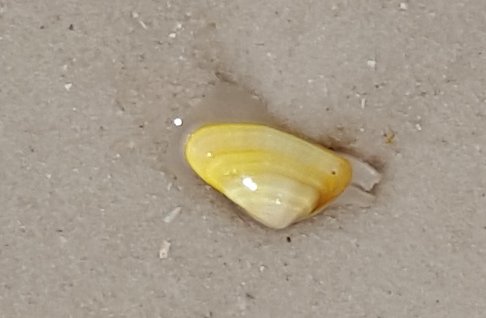Just 10-15 miles east of our campground in Mexico Beach, we could drive on the narrow spit of land known as St. Joseph peninsula. We love these narrow strips that allow for a view of the grassy calm bay on one side . . .
and the big-wave-white-sand beaches on the gulf side. These two sides are less than 1000 feet apart on this peninsula.
We have enough common sense to put our kayak into the salt water on the bay side, paddling through the grassy mazes on the edges of the bay.
This area is just a few feet deep, with perfectly clear water. We brought our snorkeling gear with us, but we could see just as much from our kayak as we could see lying on the top of the water with a mask on. We watched a stingray glide through that clear water, until he jetted away from us. Sorry, there are no good pictures of the stingray today.
The other interesting thing we saw was a curious coil under the water. Denisa first thought it was a coiled snake, and she was ready to speed paddle out of the area. But when Mark convinced her that it wasn't moving, we investigated further.
We at first couldn't decide if it was plant or animal, but it was definitely attached to the sandy floor of the bay. Mark finally managed to bring it out of the water for a closer look. An internet search later revealed that this is an empty egg case of a whelk--a large sea snail.
It was laid by a large whelk, considerably bigger than the whelk pictured below that we saw later. Each of the paperlike compartments in the egg case had around 50 eggs inside. Considering there are close to 150 capsules, this egg case would have over 7,000 eggs inside when the snail anchored it to the sea floor last fall. Egg cases like the one above are commonly called mermaid's necklaces, and sailors have used them to scrub boat decks.
As we paddled further in the bay, we looked ahead to see a fin above the water. Was it the fin of a friendly dolphin, or a sinister shark? As we studied it further from a distance, we realized it wasn't moving.
That's because our friendly dolphin had met an untimely death and was floating on the surface of the water. As we rowed closer, we could confirm from the smell that he had been dead for some time.
When we put our kayak in the water at the grassy bank, we saw hundreds of crabs scurrying to get out of our way. We found it is almost impossible to photograph these little crustaceans as they slip into their holes, but we tried anyway. The blurry moving dots on the sand were our best attempt at a picture for the blog.
Before we left St. Joseph's peninsula, we took another long walk on the gulf side beach. This area is filled with shells, so it was necessary to walk in the water just to protect our bare feet from sharp shells.
It was at the water's edge that we started seeing huge groups of these tiny colorful shells that were moving in the sand, often leaving a tiny sandy tail behind them.
If we were really fast, we could see the tiny white snail before he hid himself tightly inside the shell.
An internet search taught us that these beautiful little sea creatures are coquina clams. They come in infinite colors and shades. Marine bivalves, they grow in colonies in the sand, and make tasty treats for shore birds and crabs. People like them as well. We read that ounce for ounce there is no more delicious (or expensive) sea food in the world. But as tiny as the creature is inside, it is hard to get an ounce of meat. So man more often uses them for their shells that form into rock-like structures.
After admiring our colorful collection of coquina, we returned them to their colony and watched as they dove head first into the sand to cover themselves.
We continue to learn more about the salt water creatures that we never even knew existed. These long romantic walks on the beach have been very educational as we wander through more of God's wonders.















No comments:
Post a Comment